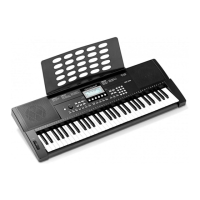How to troubleshoot no sound on my thomann Keyboard?
- TTraci RodriguezJul 27, 2025
If your thomann Keyboard isn't producing sound, there are a few things to check: * First, make sure the volume control isn't set too low or muted. * Next, verify that headphones aren't plugged into the headphone output 2, as this may silence the main speakers. * Finally, check the volume settings for R1, R2, and L on your mixer to ensure they are properly adjusted.


